Compression socks enhance blood circulation and relieve symptoms of varicose veins, deep vein thrombosis (DVT), and skin ulcers. They come in many different styles and compression levels to meet a variety of specific needs. Read on to learn about the best way to wear compression socks.
In this article, we will discuss the benefits of compression socks, the right compression socks for different needs, and general tips for sock care.
Who Should Wear Compression Socks?
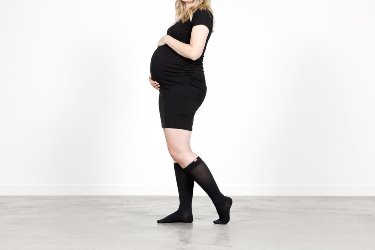
Many people can benefit from the use of medical compression socks. Athletes use them for improved recovery, and aging people use them to for enhanced circulation. They are also helpful for people who, due to work or injury, spend a lot of time standing or sitting in one place.
Pregnant women can use compression socks to combat swelling and leg pressure, while individuals with venous insufficiencies can use them to keep symptoms at bay.
Choosing the Right Compression Socks
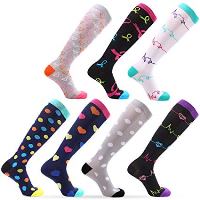
Ask your Doctor which Compression Level is Right for You
Although there are many stylish designs available, compression socks are not simply a fashion accessory. They are important medical devices, and you need to consider the reason you use them when picking out a style. Are they being used to improve circulation? Are you buying them to ease leg pain? Perhaps you have another reason?
While a properly fitted sock of the right compression level can deliver amazing benefits, remember that the wrong compression sock can actually worsen problems.
Compression Class
The compression class is determined by the amount of pressure the compression sock exerts on your leg. There are four main classes ranging from mild to extra strong. The first class, mild, provides a weak compression suitable for people who just want to improve circulation.
Generally, people who are pregnant, travel often, or work in a stationary position will use this level of compression.
| Class | Compression | Pressure mmHg |
| 1 | mild | 18 – 21 |
| 2 | moderate | 23 – 32 |
| 3 | strong | 34 – 46 |
| 4 | extra strong | At least 49 |
Medium level compression socks are great for people who are recovering from surgery or those with varicose veins, edema, or venous thrombosis. Class 3 compression is also used by those with varicose veins, venous thrombosis, and edema, depending on the severity of their individual case.
Finally, Class 4 compression socks are prescribed for those with very serious leg disease.
Since the wrong compression level can cause more harm than good, always make sure you check the compression class before investing in any compression gear!
Measure Your Ankle
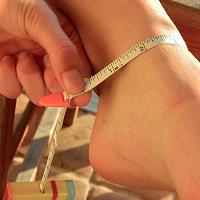
Wearing the correct size of compression socks is just as important as choosing the right compression level.
To find your size, first measure the circumference of your ankle. You can do this by placing a measuring tape around the narrowest part of the ankle. Keep in mind that the ankle bone should be below the tape. Record your measurement.
Measure the Widest Part of your Calf
Measure the circumference of your calf by placing the measuring tape around the widest part. Record this measurement as well.
Measure the Length of your Calf
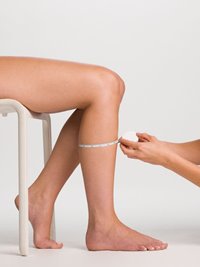
Measure the length of your calf from the bottom of the heel to the bend in the knee. You can get this measurement while sitting down so that your thigh and calf form a 90 degree angle. It may be worth asking someone for help with this one!
Measure the Widest Part of your Thigh and Leg Length
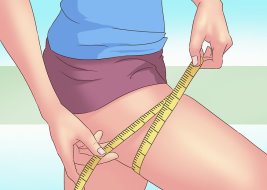
If you are only wearing knee-high socks, you can skip this step. If, however, your doctor has prescribed high compression socks, you will need these additional measurements. Measure the circumference of your thigh at the widest point and record. Then, measure the distance from the bottom of your buttocks to the floor to get your leg length. Again, it may be necessary to ask for assistance with this measurement.
Compare your Measurements to the Manufacturer’s Sizing Chart
Every compression sock company will have a size chart. Compare your measurements to the sizing charts to figure out which will be best for you. Remember that your size may vary between different companies.
Measure Again if You Lose or Gain Weight
If you have lost or gained weight since you last purchased compression socks, measure again. Do not continue to wear socks that no longer fit.
Wearing and Taking Off Compression Stockings

Wearing Compression Socks
Compression socks should be put on systematically for the best results. Follow this simple method to make things easier:
- First, take off any rings or bracelets. Then, slide your hand inside the sock and grab the heel with your thumb and forefinger.
- Then, fold down the length of the sock and put it over the tip of your foot.
- Next, position the sock so that your toes and heel are in place.
- Now, gradually unroll the sock along the length of your leg with both hands. Make sure you do not pull on the band.
- Finally, position the band. Make sure to massage out any wrinkles to ensure an even distribution of compression. If necessary, pull on the tip of the foot to release the toes.
Popular Articles on ComproGear
Rose Toy Sexual Rose Review
Super Plus Size Compression Stockings Plus Size Compression Leggings for Varicose Veins
Compression Socks for Nurses These Support Socks for Nurses Who Stand All Day
Wide Calf Compression Socks Extra Large Calf Compression Stockings
Best Compression Socks for Elderly Easy to Put on Compression Socks for Elderly
Over The Knee Compression Socks Compression Socks Above The Knee
Best Compression Socks for Sitting All Day Should I Wear Compression Socks If I Sit All Day?
Taking off Compression Socks
Compression socks should also be removed systematically. We recommend the following, easy method:
- First, grab the sock by the band and flip it down to the heel.
- Then, place your thumbs under the heel and push down so the sock only half covers the foot.
- Finally, remove the sock from the toes.
Wearing and Caring for Compression Stockings
Compression socks help with many ailments, but, if you want to use them for a long time, it is important to keep them in good shape. It’s also important to make sure you are using them correctly.
Use the Right Sock at the Right Time
Make sure you are using the right socks in the right situations.
For example, athletic compression socks exert graduated pressure. You would not use this sock to treat varicose veins. If you are unsure about when to use different types of socks, talk with your doctor.
Traveling with Compression Socks
Travel often involves a lot of sitting, which can lead to phlebitis and swelling. It can also exacerbate problems like arthritis. Travel can be especially uncomfortable for the elderly or those suffering from diabetes or hypertension. While it’s always a good idea to drink water and stretch if possible, compression socks can make a world of difference, even on the longest flights.
Time to Wear Compression Socks
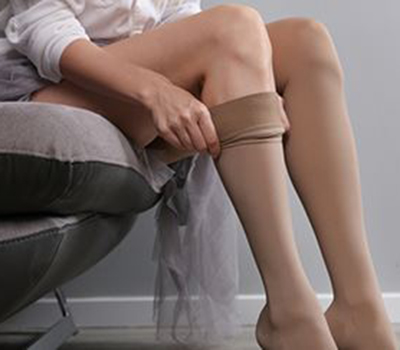
Compression socks can be worn while sitting or standing for a long period of time, but they can also relieve aches and pain after the fact. They are suitable for both the morning and the evening.
Likewise, athletic compression socks can be worn during a simple walk, during a marathon run, or during recovery.
Some people find it especially helpful to relax their legs after a hard day by laying down and putting up their feet for about ten minutes. Do not elevate them too much though! After that, they take a hot shower, then pour cold water over their feet. Then, they dry their feet and put on their compression stockings for about two hours. Many people swear by this method!
Wear the Socks Correctly
Following the steps listed above for correctly putting on compression socks is necessary if you want to experience the full benefits of your investment. It is also necessary if you want to keep your compression socks in good shape for as long as possible
Hand-Wash Stockings
We recommend hand-washing stockings over machine-washing. This will make them last longer. We also recommend washing new stockings before wearing them for the first time to ensure a proper fit.
Replace Compression Socks Every 3-6 Months
Even with proper care, compression socks usually only last about three to six months. Use after six months is not advisable if you want to properly benefit from compression. Once they begin to wear out, discard the socks and get new ones.
Take Proper Care of Your Compression Stockings
If you wear compression socks every day, you will need more than one pair. At the end of each day, hand-wash and air-dry your socks. It’s always a bad idea to put on damp socks, and they may take longer than one night to dry. Have another pair ready to go just in case.
Conclusion
Compression socks come in a variety of shapes, colors, and sizes. They are available in a variety of lengths to suit any preference and provide a wide range of health advantages for people of all activity levels. By taking good care of your socks, you will be able to enjoy their benefits for a long time to come.
